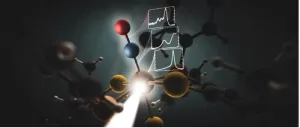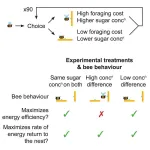(Press-News.org) The research team, led by Durham University, UK, used satellite data and radio-echo sounding techniques to map a 32,000 km2 area of land underneath the vast ice sheet.
They discovered a landscape that appears to have been formed by rivers at least 14 million years ago and possibly even before the initial growth of the East Antarctic ice around 34 million years ago.
This newly discovered landscape consists of ancient valleys and ridges, not dissimilar in size-and-scale to the glacially-modified landscape of North Wales, UK.
Its existence implies a long-term temperature stability of the ice sheet in the area investigated by the researchers.
The study has been published in the journal Nature Communications.
Lead author Professor Stewart Jamieson, in the Department of Geography, Durham University, UK, said: “The land underneath the East Antarctic Ice Sheet is less well known than the surface of Mars.
“And that’s a problem because that landscape controls the way that ice in Antarctica flows, and it controls the way it might respond to past, present and future climate change.
“So, we’re investigating a small part of that landscape in more detail to see what it can tell us about the evolution of the landscape and the evolution of the ice sheet.
“And what we find is an ancient land surface that has not been eroded by the ice sheet and instead it looks like it was created by rivers before the ice came along.
“This tells us that there hasn’t been a lot of change in this particular area, which indicates that although this part of the ice sheet may have retreated during warmer times in the past, the conditions at this site likely did not change much, and that helps us understand how the ice sheet might respond to future and ongoing warming.”
The study’s co-author Neil Ross, Professor of Polar Science and Environmental Geophysics at Newcastle University, UK, said: “It is remarkable that this landscape, ‘hidden in plain sight’ for many years, can tell us so much about the early, and long-term, history of the East Antarctic Ice Sheet, as well as helping us to understand how it might evolve in response to future climate change.
“This has been something of a slow burn project, but one that has now come to fruition in an exciting paper involving a great research team.”
The discovery builds on previous work by this team who, in collaboration with other researchers, have mapped out hidden mountain ranges, canyon systems and lakes beneath the ice in Antarctica.
Although the landscape beneath the ice sheet is not visible to the naked eye, satellite images captured over the region show small undulations of the ice sheet’s surface that provide clues about the sub-ice landscape.
In a few places, the landscape’s existence has been confirmed by using radio-echo sounding from planes to see through the ice and map the shape of the land beneath the ice sheet.
The research team proposes it is likely that there will be other, as yet undiscovered, ancient landscapes hidden beneath the East Antarctic Ice Sheet.
Professor Jamieson added: “We’ll continue exploring the landscape, doing our best to fill in gaps where surveys don’t exist, and using that information to understand how the ice sheet and its underlying landscape have changed over their long history.”
The survey data collection that underpins this work was supported by the UK Research and Innovation’s (UKRI) Natural Environment Research Council (NERC), the US National Science Foundation (NSF) and NASA.
ENDS
Media Information
Professor Stewart Jamieson of Durham University, UK, is available for interview and can be contacted on: stewart.jamieson@durham.ac.uk
Professor Neil Ross of Newcastle University, UK, is available for interview and can be contacted on: neil.ross@newcastle.ac.uk
Alternatively, please contact Durham University Communications Office for interview requests on: communications.team@durham.ac.uk.
Images and Captions
Associated images are available via the following link: https://bit.ly/405LbQg
Lifting the lid on Antarctica: Graphic shows how the landscape of Antarctica would appear if the ice were lifted away. Credit: Stewart Jamieson, Durham University
HighlandARadarSat: Satellite image of the ice surface from Radarsat with a ghost-like appearance of the mountain blocks beneath the ice. Credit: Stewart Jamieson, Durham University
HighlandARadarSatMappedLandscape: Satellite image of the ice surface from Radarsat with the valleys and ridges of the buried ancient mountains mapped. Credit: Stewart Jamieson, Durham University
RadarImage: A radar image displaying the peaks and valleys of the mountains which are buried under ice that is 2 km thick. Credit: Stewart Jamieson, Durham University
Plane1-5: Images of the plane used to conduct a partial survey of the region during the ICECAP project. Credit: ICECAP
Source Material
‘An ancient river landscape preserved beneath the East Antarctic Ice Sheet’ by Stewart S. R. Jamieson, Neil Ross, Guy J. G. Paxman, Fiona J. Clubb, Duncan A. Young, Shuai Yan, Jamin Greenbaum, Donald D. Blankenship, Martin J. Siegert is published in the journal Nature Communications. DOI: 10.1038/s41467-023-42152-2
A copy of the research paper is available by contacting communications.team@durham.ac.uk
The full paper can be accessed via the following link when the embargo lifts: https://www.nature.com/articles/s41467-023-42152-2
About Durham University
Durham University is a globally outstanding centre of teaching and research based in historic Durham City in the UK.
We are a collegiate university committed to inspiring our people to do outstanding things at Durham and in the world.
We conduct research that improves lives globally and we are ranked as a world top 100 university with an international reputation in research and education (QS World University Rankings 2024).
We are a member of the Russell Group of leading research-intensive UK universities and we are consistently ranked as a top 10 university in national league tables (Times and Sunday Times Good University Guide, Guardian University Guide and The Complete University Guide).
For more information about Durham University visit: www.durham.ac.uk/about/
END
Ancient landscape discovered beneath East Antarctic Ice Sheet
Embargoed until 11am US Eastern Time (4pm BST) Tuesday 24 October, 2023
2023-10-24
ELSE PRESS RELEASES FROM THIS DATE:
Cleveland Clinic selected by Wellcome Leap for Two Quantum Computing Research Projects
2023-10-24
Cleveland Clinic has been selected by Wellcome Leap to lead a quantum computing research project, while also playing a significant role in another led by Algorithmiq — both in collaboration with IBM Quantum.
The two contracts were won through Wellcome Leap’s Quantum for Bio Challenge, which will award up to $40 million to 12 researchers globally for research focused on accelerating the development of quantum computing applications for healthcare. Wellcome Leap is a U.S.- based non-profit organization founded by the Wellcome Trust to accelerate and increase ...
SLAC scientists shed light on potential breakthrough biomedical molecule
2023-10-24
Scientists from the Department of Energy’s SLAC National Accelerator Laboratory have gained valuable insights into producing nitroxide, a molecule with potential applications in the biomedical field. While nitric oxide (NO) has long been on researchers' radar for its significant physiological effects, its lesser-known cousin, nitroxide (HNO), has remained largely unexplored.
The study, published recently in the Journal of the American Chemical Society, was born out of a joint endeavor between teams at SLAC’s Linac Coherent Light Source (LCLS) X-ray laser and Stanford ...
Japanese registry finds use of IVUS in coronary interventions reduces mortality and need for coronary bypass surgery
2023-10-24
SAN FRANCISCO – A novel study conducted by a Japanese multicenter registry has revealed the significant benefits of using intravascular ultrasound (IVUS) in coronary intervention procedures. The comprehensive analysis, which focused on enhancing patient outcomes, has provided valuable insights into the effectiveness of IVUS in improving the success rates of these interventions.
The study, titled "Enhancing coronary intervention outcomes with the use of intravascular ultrasound: A comprehensive analysis of long-term benefits in Japanese multicenter registry," sheds light on the positive ...
NIH Kids First program releases nine new data sets for childhood cancer and congenital disorder research
2023-10-24
Philadelphia, PA., October 24, 2023
WHO: The Gabriella Miller Kids First Pediatric Research Program (Kids First), an initiative of the National Institutes of Health (NIH)
WHAT: Kids First announces the release of nine robust new pediatric research datasets spanning childhood cancers, congenital disorders, and cross-condition data. New publicly available datasets include:
PEDIATRIC CROSS-CONDITION
Kids First and INCLUDE: Down Syndrome, Heart Defects, and Acute Lymphoblastic Leukemia
Principal ...
Case report shows promising results using transcranial magnetic stimulation for post-stroke ataxia
2023-10-24
In a new case report, researchers at UCLA Health describe promising results using repetitive transcranial magnetic stimulation (rTMS) in the management of post-stroke cerebellar ataxia, a debilitating condition marked by impaired coordination and balance.
Cerebellar ataxia describes a group of neurological disorders that affect coordination, balance, and control of muscle movements. It results from damage or dysfunction of the cerebellum, a part of the brain responsible for coordinating voluntary movements. Ataxia can manifest as unsteady walking, difficulties with fine motor skills, and problems with speech, ...
$9 million award from the Department of Defense will fund groundbreaking FutureG research
2023-10-24
Lingjia Liu, professor of electrical and computer engineering who is also an inaugural faculty member at the Virginia Tech Innovation Campus, has been awarded the Mobile Distributed Multiple-Input, Multiple-Output (Mobile dMIMO) project by the U.S. Department of Defense’s (DoD’s) Office of the Under Secretary of Defense for Research and Engineering (OUSD(R&E)) as part of its flagship FutureG program. The Mobile dMIMO project consists of three phases, with $9 million total planned funding — $1.5 million is for Phase 1 of the project. The Mobile dMIMO project represents one ...
Smartphone attachment could increase racial fairness in neurological screening
2023-10-24
Engineers at the University of California San Diego have developed a smartphone attachment that could enable people to screen for a variety of neurological conditions, such as Alzheimer’s disease and traumatic brain injury, at low cost—and do so accurately regardless of their skin tone.
The technology, published in Scientific Reports, has the potential to improve the equity and accessibility of neurological screening procedures while making them widely available on all smartphone models.
The attachment fits over a smartphone’s camera and improves its ...
New methods for effective transport of large genes in gene therapy
2023-10-24
Gene therapy currently represents the most promising approach for the treatment of hereditary diseases. Yet despite significant breakthroughs in recent years, there are still a number of hurdles that hinder the wider application of gene therapies. These include the efficient delivery of genetic material into target cells with minimal side effects using adeno-associated viral vectors (AAVs). The AAV carrier substances have an advantageous safety profile and high gene transfer efficiency, meaning they are often used in gene therapies and in gene editing with CRISPR/Cas. But, AAVs have limited DNA uptake capacity ...
New tool may flag signs of pandemic-related anxiety and depression in healthcare workers
2023-10-24
An artificial intelligence tool effectively detected distress in hospital workers’ conversations with their therapists early in the pandemic, a new study shows, suggesting a potential new technology that screens for depression and anxiety.
As the coronavirus pandemic forced many hospitals to operate beyond capacity, medical workers faced overwhelming numbers of work shifts, limited rest, and increased risk of COVID-19 infection. At the same time, quarantine policies and fear of infecting family reduced their ...
Bumblebees visit flowers with more difficult-to-access nectar for immediate benefit to the colony
2023-10-24
If you’ve ever watched a bumblebee move from flower to flower, you might wonder how they decide which flower to choose and how long to stay. Now, researchers reporting in the journal iScience on October 24 have new insight based on their observations of bumblebees’ interactions with slippery artificial flowers. They found that the bumblebees make choices to maximize the rate of energy return, or the amount of sugar collected each minute.
“Bumblebees can make decisions ‘on the fly’ about which nectar sources are the most energetically economical,” said Jonathan ...
LAST 30 PRESS RELEASES:
SIMJ announces global collaborative book project in commemoration of its 75th anniversary
Air pollution exposure and birth weight
Obstructive sleep apnea risk and mental health conditions among older adults
How talking slows eye movements behind the wheel
The Ceramic Society of Japan’s Oxoate Ceramics Research Association launches new international book project
Heart-brain connection: international study reveals the role of the vagus nerve in keeping the heart young
Researchers identify Rb1 as a predictive biomarker for a new therapeutic strategy in some breast cancers
Survey reveals ethical gaps slowing AI adoption in pediatric surgery
Stimulant ADHD medications work differently than thought
AI overestimates how smart people are, according to HSE economists
HSE researchers create genome-wide map of quadruplexes
Scientists boost cell "powerhouses" to burn more calories
Automatic label checking: The missing step in making reliable medical AI
Low daily alcohol intake linked to 50% heightened mouth cancer risk in India
American Meteorological Society announces Rick Spinrad as 2026 President-Elect
Biomass-based carbon capture spotlighted in newly released global climate webinar recording
Illuminating invisible nano pollutants: advanced bioimaging tracks the full journey of emerging nanoscale contaminants in living systems
How does age affect recovery from spinal cord injury?
Novel AI tool offers prognosis for patients with head and neck cancer
Fathers’ microplastic exposure tied to their children’s metabolic problems
Research validates laboratory model for studying high-grade serous ovarian cancer
SIR 2026 delivers transformative breakthroughs in minimally invasive medicine to improve patient care
Stem Cell Reports most downloaded papers of 2025 highlight the breadth and impact of stem cell research
Oxford-led study estimates NHS spends around 3% of its primary and secondary care budget on the health impacts of heat and cold in England
A researcher’s long quest leads to a smart composite breakthrough
Urban wild bees act as “microbial sensors” of city health.
New study finds where you live affects recovery after a hip fracture
Forecasting the impact of fully automated vehicle adoption on US road traffic injuries
Alcohol-related hospitalizations from 2016 to 2022
Semaglutide and hospitalizations in patients with obesity and established cardiovascular disease
[Press-News.org] Ancient landscape discovered beneath East Antarctic Ice SheetEmbargoed until 11am US Eastern Time (4pm BST) Tuesday 24 October, 2023




